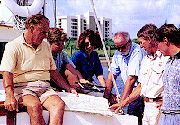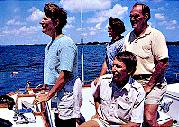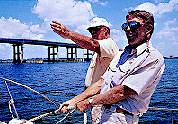|
If
your idea of a dream vacation is chartering
a bareboat in an easy-to-get tropical
paradise, but you're not too sure of
your LOPs, STDs or CMGs, Southwest Florida
Yachts of North Fort Myers has a unique
solution. Through its Florida Sailing
and Cruising School, the power of sail
and sail charter operator, owned and
run for almost 15 years by Vic and Barbara
Hansen, offers a series of livaboard
"Learn-To-Cruise" courses
that help you develop your boat-handling
and cruising skills during an enjoyable
vacation afloat. Once you pass muster,
you can charter one of SFY's boats on
your own.
 |
For
a firsthand look, I recently went along
for a powerboat course recap aboard
a Grand Banks 36 out of SFY's main base
at the Marinatown resort off the scenic
Caloosahatchee River, which separates
North Fort Myers and Cape Coral from
Fort Myers. (The sailboat base is in
nearby Charlotte Harbor.) SFY's location
is at the heart of Southwest Florida's
cruising grounds, which have been rated
"the number-one chartering area
in the U.S.," says Barbara Hansen.
Compared to the state's Atlantic coast,
it's less congested and more laid-back,
with more wide-open and wilderness areas,
as well as a vast variety of places
to go and things to see and do, from
water sports to fine waterfront dining.
You have the choice of dropping the
hook at one of the many scenic, palm-
and mangrove-lined anchorages near pristine,
gleaming-white beaches, or docking at
one of the numerous sophisticated marinas
and resorts; and you have the option
of running in the open Gulf or in the
protected waters of the various sounds
or the ICW.
SFY's
cruising parameters extend north to
Venice, taking in the lovely beach-fringed
barrier islands of Sanibel, Captiva,
Cabbage Key, Useppa, Cayo Costa and
Gasparilla; east across Okeechobee Waterway
to Stuart on the Atlantic; and south
to elegant Naples and Marco Island,
northernmost of the Ten Thousand Islands
bordering Everglades National Park.
The coastal stretch spans about 100
miles, encompassing hundreds more when
you add in the many indentations and
islands. "You can cruise this area
again and again and never cross your
own wake," says Barbara.
The
idea for the education program struck
one day when the Hansens saw someone
on a boat "looking at an AAA map
trying to figure out where they were,"
says Barbara. "We find there are
many beginners who'd like to charter
but don't even know port from starboard,
as well as lifelong boaters who can't
tie a bowline." She says about
50 percent of their students take the
course to qualify for barefoot chartering,
while another 40 percent take it because
they've just bought or plan to buy their
first boat or first big boat. The rapidly
growing power division gets close to
half the bookings.
I
found our Grand Banks 36 Classic Trawler
Blue Note sturdy, seaworthy,
spotlessly clean, beautifully maintained,
and well-equipped, with everything from
air conditioning to electronics. Powered
by twin 135-hp Ford Lehman diesels,
it has a top speed of around 8 knots
and a cruise of about 6 to 7 ideal
for exploring. Also great for cruising
is the dual-helm arrangement with roomy
bridge and spacious window-encircled
salon; while the fore-and-aft double-stateroom
layout is ideal for accomodating a family
or two couples.
No
worries
Our
"recap" group included Capt.
Gary Graham as instructor, crewman Wade
Stephan, and John and Phyllis O'Sullivan,
recent course graduates who had just
retired and moved to Cape Coral from
New York, where he was an executive
with AT&T and she was a high school
teacher. Lifelong "workaholics"
who knew "nothing at all about
boats," says Phyllis, they "decided
to try boating because it's something
we can do together in our retirement."
Now they say they feel "far more
confident" operating a boat, and
indeed seemed quite adept. They've thoroughly
enjoyed the learning process as well,
"just being out on the water, admiring
the scenery," says Phyllis. Adds
John, "When you're on a boat you
shed your worries, the 'to do' lists,
the phone, the mail, the TV, the stock
market, the IRS, the Clintons."
 |
SFY's
teaching method is mainly hands-on,
following one of Capt. Graham's favorite
Chinese proverbs, "Tell me, I forget;
show me, I remember; involve me, I understand."
Our morning at the marina included a
rundown of the basics, including Graham's
"First rule of seamanship, don't
hit anything." He stresses that
one of the keys is "to get the
boat to do what you want it to do rather
than what it wants to do." And,
he cautions, "Make the depthfinder
your best friend." Armed with these
cardinal rules and a whole lot more,
we headed out the channel into the wide
Caloosahatchee, where we anchored for
lunch, then ran up and down the river,
with the students taking turns as helmsman
and navigator. In the full course, the
class works up to taking overnight cruises
to marinas and anchorages.
Bon
voyage
Among
the subjects the courses cover are the
ship's systems and equipment; knots
and lines; helmsmanship, close-quarters
maneuvering, docking and anchoring;
compass and chart reading; plotting
a course; dead reckoning; rules of the
road; tides, currents and weather; electronics
and communications; and handling emergencies
such as engine failure, running aground
and man overboard.
 |
SFY's
instructors are all Coast Guard-licensed
captains. The fleet includes 10 diesel-powered
trawlers and motor-yachts ranging from
32 to 46 feet, available for three-
and six-day power-boat courses, and
12 sailboats from 24 to 42 feet, available
for a series or combination of five
two-day courses. There's also a one-day
Safe Boating course. The three-day powerboat
course is designed to prepare students
to skipper or crew a boat up to 40 feet
in length and to cruise safely in local
waters in moderate conditions, while
the six-day course extends the parameters
to skippering a 50-foot boat, operating
day or night in coastal or offshore
waters. That certainly makes for a
bon voyage.
Per-person
course rates, depending on the boat
and season, are $595-795 for three-day
power courses, $1095-1395 for six-day
courses, and $295-395 for two-day sailing
courses. Bare-boat charters run about
$1,000-2,200 per week for sail and $1,500-3,200
per week for power, with captains available
for an additional fee.
Southwest
Florida Yachts, Dept. MB&S, 3444
Marinatown Lane, N.W., North Fort Myers,
FL 33903. (800) 262-7939; (941) 656-1339;
fax (941) 656-2628.
|